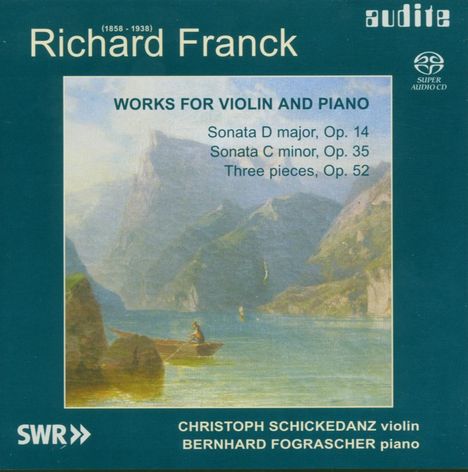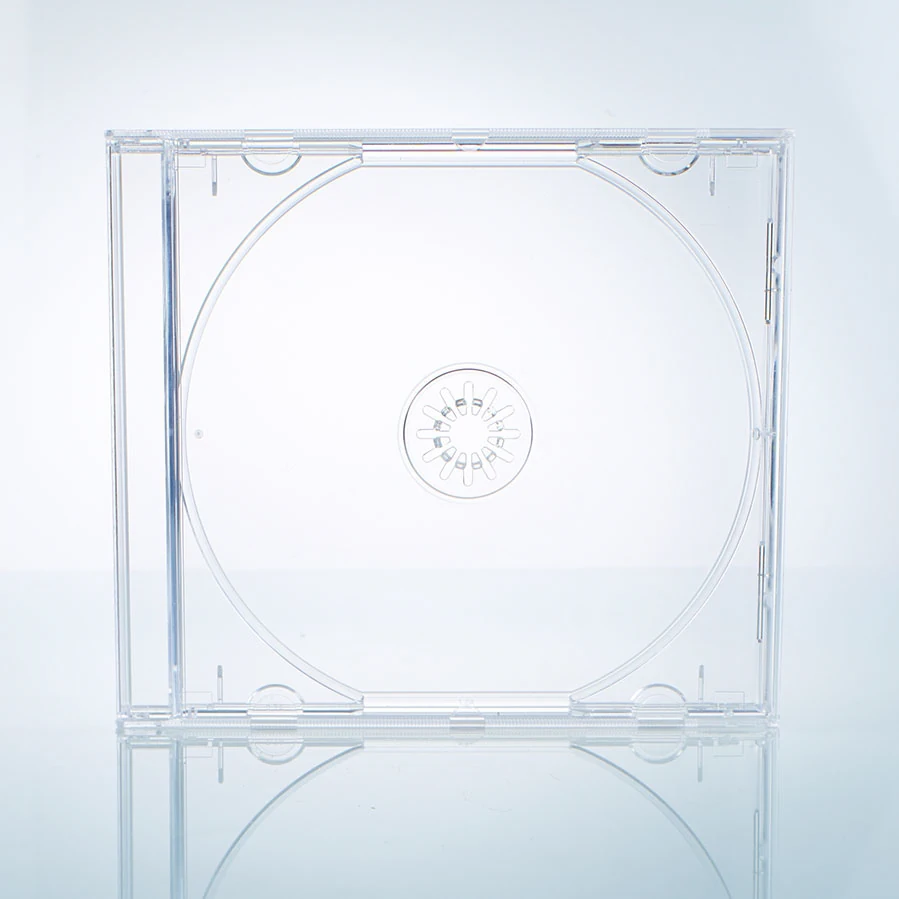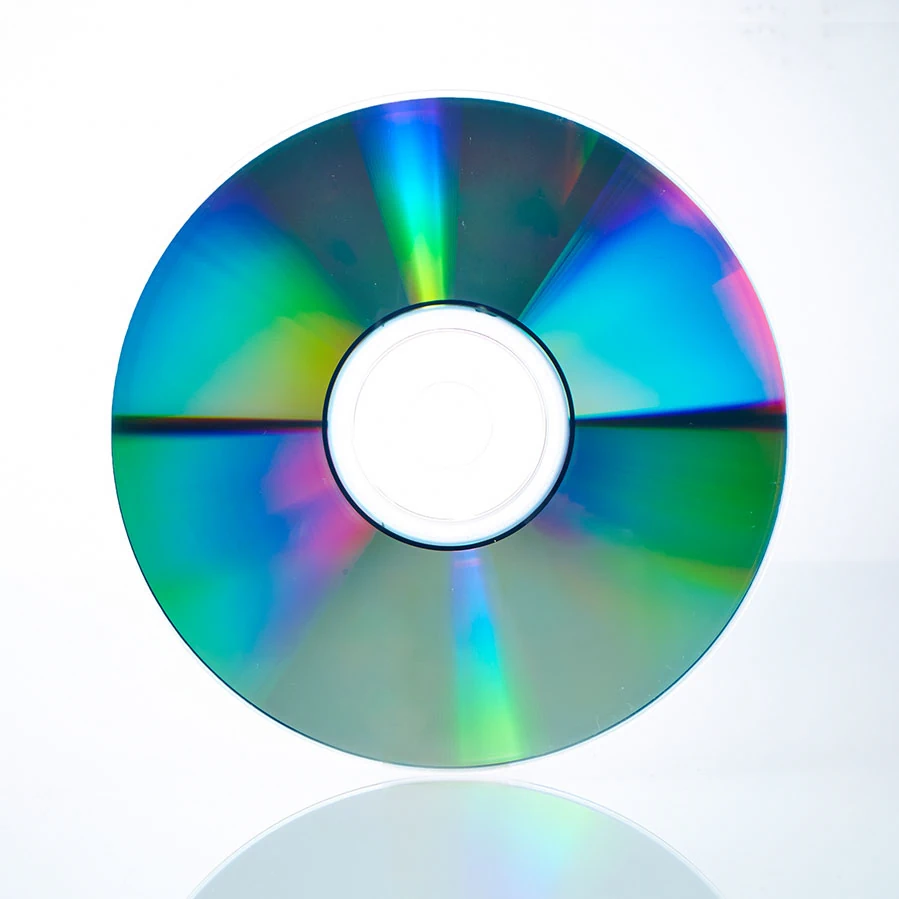Richard Franck: Werke für Violine & Klavier auf Super Audio CD
Werke für Violine & Klavier
Die SACD verwendet eine höhere digitale Auflösung als die Audio-CD und bietet außerdem die Möglichkeit, Mehrkanalton (Raumklang) zu speichern. Um die Musik in High-End-Qualität genießen zu können, wird ein spezieller SACD-Player benötigt. Dank Hybrid-Funktion sind die meisten in unserem Shop mit "SACD" gekennzeichneten Produkte auch auf herkömmlichen CD-Playern abspielbar. Dann allerdings unterscheidet sich der Sound nicht von einer normalen CD. Bei Abweichungen weisen wir gesondert darauf hin (Non-Hybrid).
(soweit verfügbar beim Lieferanten)
Violinsonaten Nr. 1 & 2 (op. 14 & 35); 3 Stücke op. 52 (Nr. 1 "Elegie";Nr. 2 "Der Reiter von St. Karli";Nr. 3 "Perpetuum mobile")
- Tonformat:
- stereo & multichannel (Hybrid)
- Künstler:
- Christoph Schickedanz (Violine), Berngard Fograscher (Klavier)
- Label:
- Audite
- Aufnahmejahr ca.:
- 2003
- Artikelnummer:
- 6239241
- UPC/EAN:
- 4022143925152
- Erscheinungstermin:
- 1.2.2007
Die SACD-Produktion mit Ersteinspielungen von Richard Franck setzt die audite-Reihe mit Werken der Komponisten Eduard und Richard Franck fort. Die Hauptschaffensphase Richard Francks fällt in die Übergangszeit zwischen 1880 und 1910, die vom Umbruch zwischen der ausgehenden Romantik und der beginnenden Moderne geprägt ist in diesem Spannungsfeld bewegt sich auch die Musik Richard Francks. In der Sonate Nr. 1 D-Dur, op. 14 von 1890 setzt sich der Komponist erstmals mit der zu dieser Zeit populären Sonatenform auseinander. Ganz im Zuge der Zeit reflektiert Franck die klassische Form, ohne daraus auszu-brechen. Die Charaktere der einzelnen Sätze reichen vom kraftvoll und einfallsreichen ersten Satz über den wal-zerartigen zweiten und innigen dritten Satz bis hin zum virtuosen letzten Satz, in dem sich der Kreis durch die Wiederaufnahme thematischen Materials aus dem ersten Satz schließt. Die Sonate Nr. 2 c-moll, op. 35 entstand 1903. Richard Franck zeigt sich hier entwicklungsfreudig und baut seine bisher gewonnenen Kompositionsprinzipien weiter aus. Das Ergebnis ist eine abwechslungsreiche Sonate, die zuweilen an Brahmsschen Umgang mit motivischem Material erinnert. Die drei kurzen Charakterstücke op. 52 zählen zu den letzten veröffentlichten Werken Francks. Die Elegie wirkt resigniert, wie ein Abschied, dem ein humorvolles Scherzo folgt den Abschluss bildet ein Perpetuum Mobile als scherzhaftes Bravourstücke im Stile des Hummelflugs. Christoph Schickedanz ist Professor an der Hochschule für Musik und Theater Hamburg. Ein DAAD-Stipendium führte ihn während des Studiums an die Indiana University in Bloomington, USA, wo er auf Bernhard Fograscher traf. Dies war der Grundstein für die fruchtbare Zusammenarbeit der beiden Künstler. Bernhard Fograscher ist Preisträger verschiedener Wettbewerbe. Seine rege Konzert- und Aufnahmetätigkeit führt ihn regelmäßig ins In- und Ausland. Das Duo Schickedanz-Fograscher hat sich zum Schwerpunkt ungewöhnliche Repertoirezusammenstellungen und zu Unrecht vernachlässigte Komponisten gewählt.
This SACD with first recordings of works by Richard Franck is a continuation of the audite series of the works of the composers Eduard and Richard Franck. The principal creative phase of Richard Franck was during the transitional period between 1880 and 1910, a time marked by a radical change from the late romantic to the beginning of the modern era. It is within this field of tension that the music of Richard Franck moves. In the Sonata No. 1 in D major, Op. 14 of 1890, the composer comes to terms for the first time with the then popular sonata form. Wholly typical of his time, Franck reflects the classical form without breaking out of it. The characters of the individual movements range from the powerful and inventive first movement to the waltz-like second and intimate third to the virtuoso final movement, in which the work comes full circle by taking up thematic material from the first movement again. The Sonata No. 2 in C minor, Op. 35 was composed in 1903. Richard Franck shows himself to be fond of development here, enlarging upon the compositional principles already mastered. The result is a highly diversified sonata, sometimes reminiscent of Brahms's way of developing motivic material. The three short Character Pieces, Op. 52 are among the last published woks of Franck. The Elegy has a resigned effect, like a farewell, followed by a humorous Scherzo the final piece is a Perpetuum Mobile, a playful virtuoso piece in "flight of the bumble-bee" style. Christoph Schickedanz is a Professor at the Academy of Music and Theatre in Hamburg. A DAAD stipend enabled him to study at Indiana University in Bloomington, USA, where he met Bernhard Fograscher. This meeting was the cornerstone for a fruitful collaboration between the two artists. Bernhard Fograscher has been a prize winner at numerous competitions. He enjoys an active concert and recording career at home and abroad. The Schickedanz-Fograscher Duo has chosen to specialize in unusual repertoire combinations and unjustly neglected composers.
Rezensionen
Die akustische Balance und das in jeder Temponuance optimale Zusammenspiel zeigen nicht nur ein herausragendes Niveau der Musiker - Perfektion, die alle Kräfte zu einer so liebevollen wie abwechslungsreichen Gestaltung freisetzt. (www. klassik-heute. de)
Rezensionen
FonoForum 03/05: "Diese CD bietet erlesenes Hörvergnügen. Da ist der klare, perfekt ausbalancierte Klang. Da sind die Interpretationen zweier hervorragend aufeinander eingespielter Musiker. Schließlich die Musik selbst: Die beiden Violinsonaten sind leuchtende Spätblüher. Traditionelle Viersätzer voller melodischer Schönheiten. Schwärmerisch."Disk 1 von 1 (SACD)
Sonate für Violine und Klavier Nr. 1 D-Dur op. 14
-
1 1. Allegro
-
2 2. Allegretto grazioso
-
3 3. Adagio molto espressivo
-
4 4. Allegro
Sonate für Violine und Klavier Nr. 2 c-moll op. 35
-
5 1. Allegro moderato
-
6 2. Allegro
-
7 3. Adagio non troppo
-
8 4. Finale: Allegro con fuoco
3 Stücke für Violine und Klavier op. 52
-
9 Nr. 1: Elegie
-
10 Nr. 2 Der Reiter von St. Karli: Allegretto
-
11 Nr. 3 Perpetuum mobile: So schnell als möglich
Mehr von Richard Franck
-
Richard FranckCellosonate op.22CDVorheriger Preis EUR 19,99, reduziert um 0%Aktueller Preis: EUR 5,99
-
Richard FranckKlaviertrios opp.20 & 32CDAktueller Preis: EUR 19,99
-
Richard FranckOrchesterwerkeCDVorheriger Preis EUR 15,99, reduziert um 0%Aktueller Preis: EUR 7,99
-
Thomas Blees,CelloCDAktueller Preis: EUR 19,99








